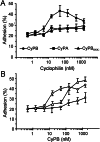Interaction with glycosaminoglycans is required for cyclophilin B to trigger integrin-mediated adhesion of peripheral blood T lymphocytes to extracellular matrix
- PMID: 11867726
- PMCID: PMC122413
- DOI: 10.1073/pnas.052284899
Interaction with glycosaminoglycans is required for cyclophilin B to trigger integrin-mediated adhesion of peripheral blood T lymphocytes to extracellular matrix
Abstract
Cyclophilins A and B (CyPA and CyPB) are cyclosporin A-binding proteins that are involved in inflammatory events. We have reported that CyPB interacts with two types of cell-surface-binding sites. The first site corresponds to a functional receptor and requires interaction with the central core of CyPB. This region is highly conserved in cyclophilins, suggesting that CyPA and CyPB might share biological activities mediated by interaction with this receptor. The second site is identified with glycosaminoglycans (GAGs), the binding region located in the N terminus of CyPB. The difference in the N-terminal extensions of CyPA and CyPB suggests that a unique interaction with GAGs might account for selective activity of CyPB. To explore this hypothesis, we analyzed the lymphocyte responses triggered by CyPA, CyPB, and CyPB(KKK-), a mutant unable to interact with GAGs. The three ligands seemed capable enough to elicit calcium signal and chemotaxis by binding to the same signaling receptor. In contrast, only CyPB enhanced firm adhesion of T cells to the extracellular matrix. This activity depended on the interactions with GAGs and signaling receptor. CyPB-mediated adhesion required CD147 presumably because it was a costimulatory molecule and was related to an activation of alpha4beta1 and alpha4beta7 integrins. Finally, we showed that CyPB was capable mainly to enhance T cell adhesion of the CD4+CD45RO+ subset. The present data indicate that CyPB rather than CyPA is a proinflammatory factor for T lymphocytes and highlight the crucial role of CyPB-GAG interaction in the chemokine-like activity of this protein.
Figures






References
-
- Handschumacher R E, Harding M W, Rice J, Drug R J, Speicher D W. Science. 1984;226:544–547. - PubMed
-
- Schreiber S L. Science. 1991;251:283–287. - PubMed
-
- Fischer G, Wittmann-Liebold B, Lang K, Kiefhaber T, Schmid F X. Nature (London) 1989;337:476–478. - PubMed
-
- Takahashi N, Hayano T, Suzuki M. Nature (London) 1989;337:473–475. - PubMed
-
- Liu J, Farmer J D, Lane W S, Friedmann J, Weissman I, Schreiber S L. Cell. 1991;66:807–815. - PubMed
Publication types
MeSH terms
Substances
LinkOut - more resources
Full Text Sources
Other Literature Sources
Molecular Biology Databases
Research Materials

